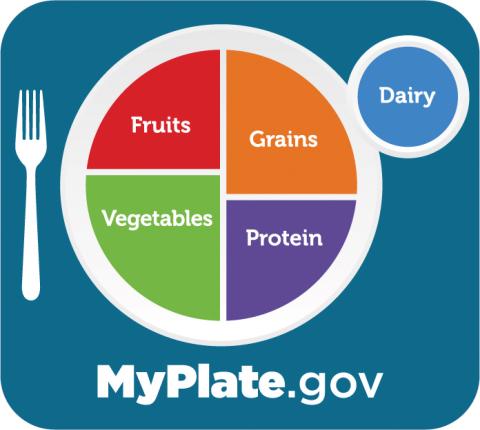
MyPlate is a simple tool that reminds you to choose a variety of foods throughout the day. It gives you a picture of what and how much to eat from each of the food groups each day, whether you eat on a plate, from a bowl, a cup, or some other way.
Eating a variety of foods from each food group will help you get the nutrients you need. The five food groups that make up MyPlate are Vegetables, Fruits, Grains, Proteins, and Dairy.
MyPlate, in a nutshell:
Make half your plate (or bowl or container) fruits and vegetables.
Choose whole grains at least half the time. Grains should take up one-fourth of the plate.
Eat a variety of protein foods from animal and plant sources. Protein should take up the other one-fourth of the of the plate.
Choose low-fat or fat-free dairy foods, including milk, yogurt, cheese.
Look to the Balance Your Plate section of the Eat.Move.Save. website to find examples of foods from each group and how much to eat each day. MyPlate.gov is another excellent place to look. Read on to learn how you can make every bite count!
Vary your veggies. Eating different kinds will help you get all the nutrients you need.
Add vegetables to things you are already eating like casseroles, sandwiches, soups, pizza, and wraps.
Fresh, frozen, and canned all count. Look for “reduced sodium” or “no-salt-added” on the label.
Focus on whole fruits like fresh, frozen, canned, or dried.
If you buy juice, select 100% fruit juice, but try to drink it only occasionally. Choose whole fruits most often because they have more fiber than juice.
Choose whole-grain versions of bread, pasta, and tortillas.
Not sure if it’s whole grain? Check the ingredients list for the words “whole” or “whole grain.”
Eat a variety of protein foods such as beans, soy, seafood, lean meats, poultry, and unsalted nuts and seeds.
Try to select seafood twice a week, if possible.
Go for leaner cuts of meat and poultry with less saturated fat.
Choose low-fat (1%) or fat-free (skim) dairy. These have the same amount of calcium and other nutrients as whole milk, but with less saturated fat and calories.
Lactose intolerant? Try lactose-free dairy milk or fortified soy milk.
Other tips from MyPlate:
Choose foods and beverages with less added sugars, saturated fat, and sodium.
Steer away from drinks with a lot of added sugar. Drink mostly water and other unsweetened drinks.
When choosing fats, eat foods like nuts, seeds, fatty fish, and oils like olive and canola, because they are good sources of unsaturated fat – a healthier fat option than saturated fat.
Don’t forget physical activity! Being active for 150 minutes (2 hours and 30 minutes) each week can help you prevent disease and manage your weight. For kids, aim for 60 minutes or more of fun physical activities each day.
Check out these other FREE tools at MyPlate.gov:
Get a personalized plan that shows you what and how much to eat: MyPlate Plan | Plan de MiPlato
Use the Start Simple with MyPlate App to set daily food goals and earn fun badges.
On your next shopping trip, use the Shop Simple with MyPlate Tool to find ways to save money in your local area and new ways to prepare budget-friendly foods.
Test your MyPlate knowledge with the MyPlate Quiz | La Prueba de MiPlato
Remember, the benefits of following the MyPlate plan will add up over time, bite by bite. Small changes matter. Keep an eye out for our next blog post where we’ll explore more tools in your Eat.Move.Save. Toolbox!

